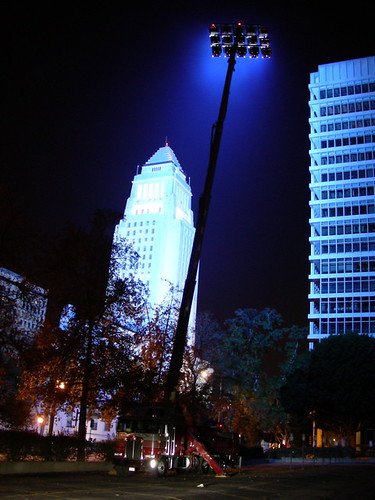L.A. Mayor Urges Water Use Cuts;
What Farmlab is Doing
Los Angeles Mayor Antonio Villaraigosa held a press conference this week where, citing the lack of rainfall in the city, he urged Angelinos to reduce their water consumption by 10%.
Here's the first three paragraphs from the Associated Press story:
The city's nearly 4 million residents were urged Wednesday to cut their water use by 10 percent as the West's lengthening dry spell raises concerns about future supplies.
Record-low rainfall, a potentially hot summer and a disappointing snowpack in the Eastern Sierra, where the nation's second-largest city gets much of its water, could lead to future severe drought conditions, said Mayor Antonio Villaraigosa
"Los Angeles needs to change course and conserve water to steer clear of this perfect storm," Villaraigosa said. "The combination of record-low rainfall, the second-lowest snowpack ever recorded and a potentially very hot summer is a perfect storm that could put Los Angeles into a drought."

Farmlab is located in the historic core and geographic center of Los Angeles. City Hall -- here, lit in azure about 18 months ago by our team during the Not A Cornfield project's Blue Phase -- is visible from the side street that services our warehouse headquarters.
What then, are we doing to conserve?
We've installed low-flow toilets; we've set up catch basins -- admittedly, of little use when only a couple of inches of rain have fallen during the past year; and most significantly, the agbin planters that pepper the grounds Under Spring, filled with vegetables, fruits, flowers, and succulents, are expertly watered by Gerardo Vaquero Rosas, an agriculturalist and Farmlab Artist-In-Resident. Rosas takes care not to waste water, nor over-water.
That said, what do we still need to do to further conserve, and not waste water?
After reading the Mayor's remarks, we did a quick check of the half-dozen or so faucets in and around our facilities. Two are leaking slightly. Fixing a leak, according to the Mayor -- although presumably a more major one -- could save as much as twenty gallons of water daily.

Readers of this blog -- please feel free to pass along via comment, phone call, or in-person, any other suggestions for how to better conserve H20, either at our warehouse, or in all of our lives in general.
UPDATE: Farmlab Team member Jaime Lopez Wolters adds this information on August 1: "The water going down the sink in our indoor nursery is captured and reused to water the plants. The grey water going down one of the kitchen sinks is aptured in an agbin growing hops and other vegetables."

3 Comments:
You can get aerators for your faucets that will restrict the water flow to .7 gpm. It's a spray, which people may not like, but it saves a lot of water over time. They sell them at hardware stores.
You mentioned toilets. The DWP will install low-flow toilets for free and they'll throw in a low-flow shower head with a navy shower switch for free.
for those with lawns: cover and smother;; then mulch and plant with native;drought tolerant plants!
check out jenkins' "humanure handbook"--3rd edition online for free at his website. the human -waste-into-the-water/flush-away framework is apparently something to look very closely at. billions of gallons of water wasted. sewage treated, mixed with chlorine and released back into the earth. additionally sewage spills/plumes closing ocean beaches 20% percent of the time? (water waste and ground water pollutant). most amazing: this substance when properly composted (an odorless two-year process mind you) becomes humus. a rich soil amendment. (stop production on that petroleum-based nitrogen fertilizer everybody!) i'm just starting mine, we'll see how this works in an urban setting. i'm beyond curious. on a grand scale, this seems a fundamentally key cycle to revitalize.
Post a Comment
Subscribe to Post Comments [Atom]
<< Home